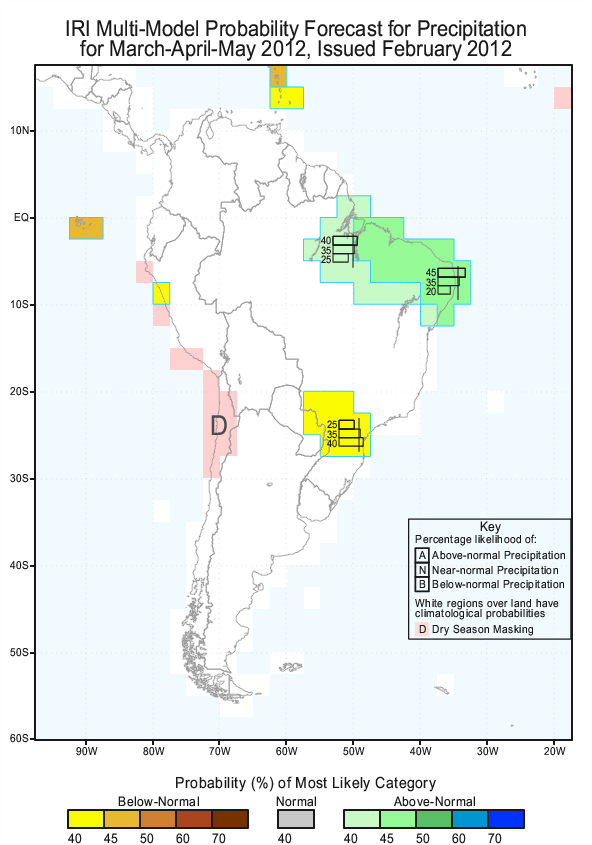| March 1, 2012 | No. 48 |
February 2012
I posted the February weather data for the Palmira Weather Station today. We had no rain recorded for the month of February here at the Palmira Station. Terry Zach in El Santuario reports 2.80 inches of rain. Steve Sarner in Jaramillo Arriba reports 1.01 inches. Sela Burkholder in Jaramillo Abajo reports 0.10inches. Craig Bennett in Los Naranjos reports 1.21 inches. Here is the list from least to most rainfall ifor the month of February followed by the month of January 2012.
Rainfall for February 2012 |
||
| Palmira Arriba | Lloyd Cripe | 0.00 |
| Jaramillo Abajo | Sela Burkholder | 0.10 |
| Jaramillo Arriba | Steve Sarner | 1.01 |
| Los Naranjos | Craig Bennett | 1.21 |
| El Santuario | Terry Zach | 2.8 |
Rainfall for January 2012 |
||
| Palmira Arriba | Lloyd Cripe | 0.47 |
| Jaramillo Abajo | Sela Burkholder | 1.06 |
| Los Naranjos | Craig Bennett | 3.11 |
| Jaramillo Arriba | Steve Sarner | 3.18 |
| El Santuario | Terry Zach | 5.75 |
The charts for the two months indicate an interesting pattern of rain during the dry season. Palmira is the driest reporting area. We get very little Bajareque (mist) from the Caribbean moisture debris. The El Santuario area (north of downtown Boquete) gets the most moisture from the Bajareque. If you take a drive in these areas you see the effects of this on plants. The plants in the Palmira area (southwest of downtown Boquete) look dry and stressed while plants in El Santuario look green and vibrant. The Bajareque is like a giant mister that the plants enjoy. It would help to have some irrigation in the Palmira area, but since we don't have any reliable source of irrigation water on our finca, we just let the grass and plants get dry and wait for the rainy season to eventually show up and freshen things up again. Once the rain starts, the plants that have survived, quickly return to green.
The NE Trade winds continue to blow. They are a bit wearing this time of year, but not unexpected. Depending on where you live in the District, they can be rather mild or quite strong. The Alto Boquete area gets a lot of wind. We are somewhat protected from the winds here in Palmira but get our fair share. At the Palmira Station the average winds have been 10.4 mph with a max wind of 41 mph for the month of January and 10.2 mph with a max wind of 32.8 mph for the month of February. I don't have wind data for other Boquete areas but would expect much stronger winds in the Alto Boquete and Jaramillo Abajo areas. The winds will continue this month and gradually taper off as we move into April. This is the usual pattern. People tend to forget that January, February and March are windy months here in Boquete. The Trade Winds are commonly with us during this time. The locals call it "El Norte" and know that it holds the rain off from the south. When El Norte dies down, the rainy season begins. All of this is related to the position of the ITCZ and the winter weather systems up north.
Some have asked why we get so much wind out of the NE during the dry season? The short simple answer is that it is due to pressures and temperatures. We are in a low pressure and high temperature area of the world. This time of the year, just north of us in North America are cold temperatures and often high pressures. Cold air and high pressures want to rush toward the low pressure and high temperature areas so it comes our way. You can see the worldwide status of air pressure by checking out the Unified Surface Analysis Chart on a regular basis. Today's chart indicates a lot of high pressure in the north with cold fronts pushing south. We have a very low pressure area in our region so the air is rushing toward us. It is windy here today.
The ENSO is still in a La Niña condition but transitioning. La Niña has peaked and is expected to transition to neutral conditions during March through May of 2012. Here is the link to the latest La Niña report.
For information from the National Weather Service JetStream - Online School for Weather regarding the Weather Impacts of ENSO visit their web page.
If interested, you can monitor the status of La Niña and get weekly updates at the NOAA Climate Prediction Center at this link.
The IRI (International Research Institute for Climate and Society) is not reporting any unusual probabilities of precipitation for our region for March through May. Here is their graphic presentation: (Note no color coding for our area):

If you have any interest in doing some bird watching here in Boquete while waiting for some rain to come along, here is a link to some of my photos of the more Common Boquete Birds. The names are below the enlarged photos. You probably have seen some of them in your backyards. In case you didn't know it, people come from all over the world to see our birds. They are very special. Don't overlook them.
You probably won't need your very dry umbrellas for some time so use them to shade the sun and keep them handy in the stand where you can find them some time in April. It is however recommended that you get a good supply of ChapStick and use it liberally to keep those lips from cracking and burning.
Lloyd Cripe
